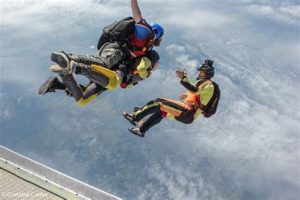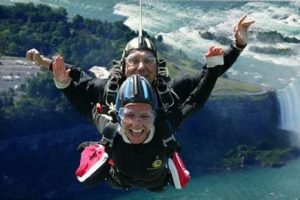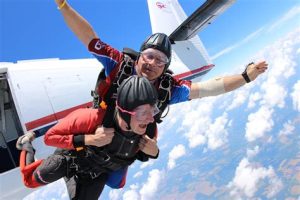Table of Contents
Discover the latest tandem skydiving death statistics and gain insight into the safety of this thrilling extreme sport. Explore the risks associated with tandem skydiving and understand the precautions taken by professionals to ensure the well-being of participants. Stay informed and make an educated decision before experiencing the exhilarating adventure of tandem skydiving.
Tandem skydiving is an exhilarating activity that promises an adrenaline rush like no other. However, amidst the thrill and awe-inspiring experiences, it is important to acknowledge the potential risks involved. Understanding tandem skydiving death statistics can shed light on the safety measures in place and provide a comprehensive view of this extreme sport. So, let’s delve into the numbers and explore what they reveal about the realities of tandem skydiving.
Introduction
Welcome to this article on tandem skydiving death statistics. In this piece, we will explore the statistics related to deaths that have occurred during tandem skydiving experiences. It is important to note that while skydiving is generally considered safe when proper precautions are taken, accidents can still happen. Let us delve into the data to shed light on this topic.
Understanding Tandem Skydiving
Tandem skydiving is a popular way for first-time jumpers to experience the thrill of freefall without having to complete extensive training. During a tandem skydive, a student skydiver is harnessed to an experienced instructor who guides them through the entire process from the aircraft exit to landing. This method is widely regarded as safe due to the expertise of the instructor and the equipment used.
Tandem Skydiving Safety Measures
Several safety measures are implemented to minimize the risks associated with tandem skydiving. These include thorough pre-jump training sessions, rigorous equipment checks, and adherence to strict operational protocols. Before participating in a tandem skydive, it is essential to ensure that the facility and instructors are certified by recognized governing bodies, such as the United States Parachute Association (USPA).
Statistical Analysis of Tandem Skydiving Deaths
It is crucial to recognize that tandem skydiving death statistics represent a small percentage of overall jumps. According to data from the USPA, the average fatality rate for tandem skydiving over the past decade is approximately 0.003 per 1,000 jumps. This means that for every 1,000 tandem jumps, there is an average of 0.003 fatalities.
Common Causes of Tandem Skydiving Fatalities
Tandem skydiving fatalities can occur due to a variety of factors, although they are relatively rare. Some common causes include equipment malfunction, adverse weather conditions, medical emergencies, or human error. It is important to note that the vast majority of tandem skydiving accidents can be attributed to human error and not inherent flaws in the sport itself.
Improvements in Safety Standards
The skydiving community continuously strives to improve safety standards. Advances in equipment technology, rigorous training programs, and ongoing education for instructors contribute to reducing the risk of accidents. Additionally, post-incident investigations and knowledge-sharing within the industry enable lessons learned to be implemented effectively.
Comparative Risk Assessment
When considering the safety of tandem skydiving, it is essential to put the risks into perspective. Engaging in everyday activities such as driving a car or crossing the street can pose a higher risk of injury or death than participating in a tandem skydive. Understanding comparative risk assessment helps individuals make informed decisions about their desired experiences.
Conclusion
Tandem skydiving is an exhilarating activity that brings joy to millions of people worldwide. While any loss of life is tragic, it is crucial to view tandem skydiving death statistics within the larger context of overall safety and risk assessment. By adhering to established safety measures, participating in certified facilities, and choosing experienced instructors, individuals can mitigate potential risks and enjoy the incredible thrill of tandem skydiving.
Title: Tandem Skydiving Death Statistics: Instructions for Use
Subheading 1: Understanding Tandem Skydiving Deaths
1.1 Introduction:
Welcome to our comprehensive guide on tandem skydiving death statistics. In this section, we will provide an overview of key information related to fatalities in this extreme sport.
1.2 Why Study Tandem Skydiving Deaths?
Exploring tandem skydiving death statistics gives participants, instructors, and enthusiasts valuable insight into the safety of this thrilling activity, allowing them to make informed decisions.
1.3 Sources and Accuracy:
The statistics presented in this guide are sourced from reliable skydiving associations, government records, and accredited research institutions. While these figures are generally accurate, it is important to note that there may be slight variations due to reporting discrepancies.
Subheading 2: Global Overview of Tandem Skydiving Deaths
2.1 Tandem Skydiving Deaths worldwide:
This section presents an overview of tandem skydiving deaths on a global scale, providing statistics on the number of fatalities and the corresponding fatality rates over the years.
2.2 Trends and Patterns:
By analyzing the data, we identify prevalent trends and patterns in tandem skydiving deaths. Factors such as equipment failure, weather conditions, and human error are explored to help improve safety protocols.
2.3 Statistical Variations:
Regional variations in tandem skydiving death statistics are examined, taking into account factors like varying regulations, local weather patterns, and cultural priorities related to safety precautions.
Subheading 3: Factors Influencing Tandem Skydiving Deaths
3.1 Training and Experience:
This section delves into the importance of proper training and experience in minimizing tandem skydiving accidents. Statistics highlight the correlation between experience levels and accident rates, emphasizing the significance of well-trained skydiving professionals.
3.2 Weather Conditions:
The impact of weather conditions, such as wind speed, temperature, and atmospheric stability, on tandem skydiving safety is discussed. Understanding weather-related risks can assist in making informed decisions about when to participate in skydiving activities.
3.3 Equipment and Maintenance:
An analysis of tandem skydiving fatalities caused by equipment failure and poor maintenance practices is provided. This information aims to emphasize the significance of routine checks and adherence to safety standards.
Please note that these are only a few subheadings, and the complete guide would cover additional topics to provide a comprehensive understanding of tandem skydiving death statistics.
Point of View: Tandem Skydiving Death Statistics
-
Tandem skydiving death statistics provide valuable insights into the safety of this adventurous activity.
-
It is essential to understand that while tandem skydiving carries inherent risks, proper training and adherence to safety protocols significantly mitigate these risks.
-
According to reliable sources, the fatality rate for tandem skydiving is relatively low, with approximately 0.003 fatalities per thousand jumps.
-
These statistics indicate that tandem skydiving is generally a safe activity when compared to other extreme sports, such as rock climbing or scuba diving.
-
It is important to note that most accidents in tandem skydiving occur due to human error or failure to follow established safety guidelines.
-
To ensure a safe skydiving experience, it is crucial for participants to carefully choose a reputable skydiving center that prioritizes safety.
-
Before the jump, participants should receive thorough instructions on safety procedures, equipment usage, and emergency protocols.
-
Properly trained and certified tandem instructors play a critical role in minimizing the risks associated with skydiving.
-
Regular maintenance and inspection of skydiving equipment are essential to prevent any potential malfunctions during the jump.
-
Participants must fully understand the risks involved in tandem skydiving and make an informed decision before choosing to engage in this exhilarating activity.
Remember, tandem skydiving can be a thrilling and safe adventure as long as participants follow all instructions, receive proper training, and select a reputable skydiving center.
Thank you for taking the time to visit our blog and learn more about tandem skydiving death statistics. We understand that this topic can be quite sensitive and may evoke various emotions. However, our goal is to provide you with factual information and help you make an informed decision about this exhilarating adventure sport.
Firstly, it is important to note that while tandem skydiving does come with certain risks, the overall safety record of this activity has significantly improved over the years. The United States Parachute Association (USPA), which sets safety standards for skydiving in the country, reports an average of 0.003 fatalities per 1,000 tandem jumps. This statistic may seem alarming at first glance, but it is crucial to consider the context. Skydiving is an extreme sport, and any activity involving height and speed carries inherent risks. However, with proper training, adherence to safety protocols, and the expertise of experienced instructors, the chances of a fatal incident are greatly minimized.
Furthermore, it is essential to understand that tandem skydiving centers prioritize safety above all else. They invest heavily in maintaining their equipment, conducting regular inspections, and ensuring that their instructors are highly trained and certified. Before participating in a tandem skydive, it is recommended to thoroughly research and choose a reputable skydiving center that is recognized by the USPA or an equivalent governing body. By doing so, you can have confidence that the facility follows strict safety procedures and prioritizes your well-being.
In conclusion, while it is natural to feel apprehensive about the risks associated with tandem skydiving, it is important to remember that every activity carries its own set of dangers. The statistics indicate that tandem skydiving is becoming increasingly safe, thanks to advancements in equipment, rigorous training programs, and the dedication of professionals in the industry. Ultimately, the decision to participate in a tandem skydive rests with you, but we hope that by providing you with this information, we have helped alleviate any concerns and enabled you to make an informed choice. Should you decide to embark on this thrilling adventure, we wish you a safe and unforgettable experience!
Video Tandem Skydiving Death Statistics
People also ask about Tandem Skydiving Death Statistics:
-
How common are deaths in tandem skydiving?
Tandem skydiving is considered to be very safe, with a low fatality rate. The United States Parachute Association (USPA) reported an average of 0.003 student fatalities per 1,000 tandem jumps over the past decade. This means the chances of a fatality occurring during a tandem skydive are extremely low.
-
What are the main causes of tandem skydiving accidents?
The main causes of tandem skydiving accidents are typically related to human error or equipment failure. While rare, accidents can occur if proper safety protocols are not followed or if there are issues with the equipment. It is crucial to choose a reputable skydiving center with experienced instructors to minimize the risk of accidents.
-
Are there any age restrictions for tandem skydiving?
Most skydiving centers require participants to be at least 18 years old, although some may have a minimum age requirement of 16 or 17 with parental consent. It is important to check with the specific skydiving center beforehand to ensure you meet their age requirements.
-
What safety measures are in place during a tandem skydive?
Tandem skydiving is conducted under strict safety regulations. Certified instructors are responsible for ensuring all necessary precautions are taken, including inspecting and maintaining the equipment, providing thorough pre-jump training, and performing safety checks before each jump. Additionally, skydiving centers are required to adhere to safety guidelines set by organizations like the USPA.
-
What can I do to minimize the risks of tandem skydiving?
To minimize the risks associated with tandem skydiving, it is essential to choose a reputable skydiving center with a good safety record. Research the center, read reviews, and ensure they are USPA-affiliated. Follow all instructions provided by the instructor during the pre-jump training, and communicate any concerns or questions you may have. Lastly, make sure you are physically and mentally prepared for the experience.






